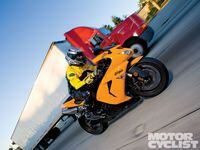Street Savvy
I 'm bumping against the 65-mph governor in the center lane of a flat stretch of freeway, pulling a set of pup trailers, when I come upon a slow moving four-wheeler-what we diesel dummies call a car. Passing on the right isn't an option, so I spot an opening in the hammer lane, hit the blinker, check the mirrors and go.
Getting back to 65 mph doesn't take long, but just as my rear trailer's axle is even with the car's front bumper, its driver decides she's not going to be passed by some damned semi! Now I'm going 65 in the left lane. Not good. By the time she makes room in the center lane, a couple of two-wheelers scream by on the right. As I recheck my mirrors to move over, two more whiz past. A Yamaha R1 rider-complete with race-replica jacket and helmet strapped to the side of his bike-hoists a single-finger salute.
I shake my head, check the mirrors again and move over. Not good enough: Squidworth decides to brake-check me. Then he turns around, looks me in the eye, grabs a handful of throttle and flips me the bird again!
After riding motorcycles for 18 years, I knew semis were big, heavy and needed space. When I got a commercial driver's license five years ago, I found out exactly how big and heavy they are. There's a huge difference between riding my Triumph Daytona 675 to work and then climbing into a semi.
The over-the-road rig I used to drive weighed in at 33,000 pounds with nothing in the wagon. Add 40,000 lbs. worth of freight and it's 73,000 lbs. with room for another 7000 if need be. With certain types of freight, shippers can flirt with the 80,000-lb. limit. Haulers with "OVERSIZED" banners can weigh upwards of 200,000 lbs.
To accommodate that kind of weight, tractors and trailers use heavy-duty leaf springs that don't allow an optimal contact patch under lighter loads. It's like stabbing the brake pedal on a sportbike after grabbing the front lever. Semi tires are made to last. Durability trumps traction. That can add up to a skid. Two trailers are more dangerous because the rear one can jackknife, and the only cure for that is stepping off the brakes. Some weight in the trailer(s) helps keep things more stable, but too much is like trying to stop a mob of teenage girls from rushing the stage at a Jonas Brothers concert.
Trust me, truck drivers don't want to get in your way. Getting that tonnage up to speed takes time; so does slowing it down. When you include reaction time and the 1-second delay for air brakes, a loaded semi needs almost 600 feet to stop from 65 mph. Our friend on the R1 could have stopped in about 150 feet, which means I would have had to get out and run nearly two football fields to see if there was enough left of him to identify.
Brake-checking a semi on a motorcycle is insane. After nearly 500,000 road miles, I've seen the good, the bad and the ugly. This one could have turned seriously ugly. So next time you're staring at the back of a semi-trailer, cut the guy behind the wheel some slack. Let him see you. Give him a chance to get back over to the right. We all have to share the road out there. Let's do it with the dirty side down and the shiny side up.













/cloudfront-us-east-1.images.arcpublishing.com/octane/HXOUJXQWA5HBHGRO3EMJIGFMVI.jpg)

/cloudfront-us-east-1.images.arcpublishing.com/octane/3TIWWRV4JBBOLDVGRYECVVTA7Y.jpg)
/cloudfront-us-east-1.images.arcpublishing.com/octane/KIX5O23D5NAIBGFXBN3327DKZU.jpg)
/cloudfront-us-east-1.images.arcpublishing.com/octane/7GJYDUIPXRGMTMQKN6ONYOLBOU.jpg)
/cloudfront-us-east-1.images.arcpublishing.com/octane/MUQLOVLL2ZDGFH25ILABNBXKTI.jpg)
/cloudfront-us-east-1.images.arcpublishing.com/octane/TNOU5DNE2BC57MFPMGN2EIDXAM.jpg)
/cloudfront-us-east-1.images.arcpublishing.com/octane/GTCXACQGJ5HAPDTGWUQKDEH44E.jpg)
/cloudfront-us-east-1.images.arcpublishing.com/octane/S35YGSEMEZB4BLTDJTSZPF4GLA.jpg)
/cloudfront-us-east-1.images.arcpublishing.com/octane/5UOT6HPX2JFMRJAX6EH45AR4MQ.jpg)
/cloudfront-us-east-1.images.arcpublishing.com/octane/OKWOJWAKP5EP3OACCRRWPCIX2Q.jpg)
/cloudfront-us-east-1.images.arcpublishing.com/octane/2WF3SCE3NFBQXLDNJM7KMXA45E.jpg)
/cloudfront-us-east-1.images.arcpublishing.com/octane/G4MG6OUCJNBSHIS2MVVOTPX65E.jpg)
/cloudfront-us-east-1.images.arcpublishing.com/octane/IIGGWFOTOJGB7DB6DGBXCCMTDY.jpg)
/cloudfront-us-east-1.images.arcpublishing.com/octane/QSTCM6AVEZA5JJBUXNIQ3DSOF4.jpg)
/cloudfront-us-east-1.images.arcpublishing.com/octane/U4I7G625B5DMLF2DVIJDFZVV6M.jpg)
/cloudfront-us-east-1.images.arcpublishing.com/octane/B6XD6LS6IVCQPIU6HXDJSM3FHY.jpg)
/cloudfront-us-east-1.images.arcpublishing.com/octane/ICL63FEDDRDTTMINYICCEYGMDA.jpg)
/cloudfront-us-east-1.images.arcpublishing.com/octane/FCGZHQXRBZFLBAPC5SDIQLVF4I.jpg)
/cloudfront-us-east-1.images.arcpublishing.com/octane/WNOB6LDOIFFHJKPSVIWDYUGOPM.jpg)

/cloudfront-us-east-1.images.arcpublishing.com/octane/X33NU3E525ECRHXLNUJN2FTRKI.jpg)
/cloudfront-us-east-1.images.arcpublishing.com/octane/6KKT5NNL2JAVBOXMZYS5ZO76YA.jpg)
/cloudfront-us-east-1.images.arcpublishing.com/octane/J5RKG5O455GMPGQRF2OG6LRT7A.jpg)